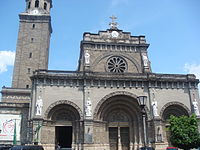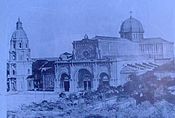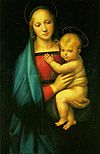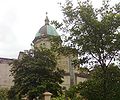- Manila Cathedral
-
Manila Metropolitan Cathedral-Basilica
Cathedral-Basilica of the Immaculate Conception
Manila Cathedral
Basic information Location 14°35′29″N 120°58′25″E / 14.59147°N 120.97356°ECoordinates: 14°35′29″N 120°58′25″E / 14.59147°N 120.97356°E Affiliation Roman Catholic District Archdiocese of Manila Ecclesiastical or organizational status Minor Basilica Architectural description Architectural type Cathedral Architectural style Neo-Romanesque Groundbreaking 1954 Completed 1958 Specifications The Manila Metropolitan Cathedral-Basilica (also known as the Cathedral-Basilica of the Immaculate Conception and informally as Manila Cathedral) is a prominent Latin Rite Roman Catholic basilica located in Manila, Philippines, honoring the Blessed Virgin Mary as Our Lady of the Immaculate Conception, the Patroness of the Philippines. Located in the Intramuros district of Manila in the Philippines. Originally a parish church owned by the diocese of Mexico in 1571, it became a separate diocese with its own bishop. The cathedral serves both as the Prime Basilica of the Philippines and highest seat of Archbishop in the country. The cathedral has been damaged and destroyed several times since the original cathedral was built in 1581; the sixth and current incarnation of the cathedral was completed in 1958 and was consecrated as a minor basilica in 1981. It is the highest seat of the Roman Catholic Archdiocese of the Philippines, the current Archpriest of the Cathedral is Cardinal Gaudencio Rosales.
Contents
History
The first cathedral, made of nipa and bamboo, was constructed in 1581. It was damaged by a typhoon in 1582 and razed by fire in 1583.
The second cathedral, which was made of stone, was built in 1592. It was destroyed by an earthquake in 1600.
Construction of the third cathedral began in 1614. The new structure, consisting of three naves and seven chapels, was blessed in 1614. It was toppled by another earthquake which shook Manila in 1645.
The magnificent fourth cathedral was constructed from 1654 to 1671. It was severely damaged in 1863 by a very strong earthquake that also damaged the Palace of the Governor General of the Philippines. In 1880, another earthquake toppled its bell tower, rendering the cathedral towerless until 1959.
The fifth cathedral was constructed from 1870–1879. It was solemnly blessed in December of 1879. The cross atop the central dome is a reference point of astronomical longitudes of the archipelago. This incarnation of the cathedral was reduced to rubble by the bombing in 1945 during the Battle of Manila.
Two Popes have celebrated Mass in the Cathedral, Pope Paul VI in 1971 and Blessed Pope John Paul II in 1982, in which he declared it a Minor Basilica through a Motu Proprio.
General articles
Overview of Mariology •
Veneration of the Blessed Virgin • History of MariologyExpressions of devotion
Art • Hymns • Music • ArchitectureSpecific articles
Apparitions • Saints • Popes • Societies • Hearts of Jesus & Mary • Consecration to MaryThe present cathedral was constructed from 1954 to 1958 during the tenure of Manila Archbishop Rufino Jiao Cardinal Santos, and under the supervision of architect Fernando Ocampo. It was elevated to the rank of minor basilica in 1981 by Pope John Paul II.
50th Restoration anniversary
The Catholic Bishops Conference of the Philippines (CBCP) announced the highlights of activities for December 8, on the occasion of the Cathedral's 50th restoration anniversary - the second Manila Cathedral Pipe Organ Festival on December 2, 5, 6, 7, 8 and 10.[1]
Burials and funerals
The cathedral is the resting place for former prelates who have served the Archdiocese of Manila. Among those interred in the cathedral crypts (similar in style to that of St. Peter's Basilica in Vatican City) are:
- Michael J. O'Doherty, the last foreign Archbishop of Manila;
- Gabriel Reyes, the first Filipino Archbishop of Manila;
- Rufino Jiao Santos, the first Filipino Cardinal;
- Jaime L. Cardinal Sin, the prelate who is considered to be one of the leaders of the People Power Revolution.
It also hosted two funerals for two former Presidents of the Philippines:
- Carlos P. Garcia, 8th President of the Philippines (1957-1961);
- Corazon Aquino, 11th President of the Philippines (1986-1992).
The Cathedral was recently used as a venue for the wake and requiem mass for former President of the Philippines Corazon Aquino, who died on August 1, 2009. In an unprecedented move by the Archdiocese of Manila, protocol was not observed in permitting Aquino's remains to lie in state at the Cathedral, making her the first woman to have been permitted to do lie in state, as only Archbishops of Manila are accorded this honor. Former president Carlos P. Garcia was the first layperson to lie in state and have a requiem mass at the cathedral.[2]
Rectors
Among the notable rectors of the cathedral were Rev. Msgr. Domingo Cirilos (1985 to 1996), the current parish priest of San Fernando de Dilao Parish in Paco, Manila, and Rev. Msgr. Hernando Coronel (1996 to 2002), the current rector of the archdiocesan seminary, San Carlos Seminary in Guadalupe Viejo, Makati City. The present rector since 2002 is Msgr. Nestor Cerbo, a former formator and was the Vice-Rector of San Carlos.
Architecture
The main façade of the Manila Cathedral is graced by statues of famous saints sculpted in Roman travertine stone. In the old cathedral, they were originally made of molave wood.
The saints are St. Rose of Lima, patroness of the Philippines by Angelo Fattinanzi, St. Jacob the Great, St. Andrew the Apostle, preacher of the faith in many corners of Asia and patron of saint of Manila, by Livia Papini; St. Francis Xavier, apostle of the Indies, by Alcide Tico; St. Polycarp, old bishop of Smyrna, by Alcide Tico; and St. Anthony Abbot, founder of Oriental monasticism, by Livia Papini.
Images of the Manila Cathedral
-
Inscription on the tympanum of the main door
See also
References
- ^ GMA NEWS.TV, gmanews.tv/story, Activities lined up for Manila Cathedral's 50th restoration anniversary
- ^ Quezon, Manolo (2009-08-13). "Notes on the Aquino funeral". The Philippine Daily Inquirer. INQUIRER.net. http://opinion.inquirer.net/inquireropinion/columns/view/20090813-220022/Notes-on-the-Aquino-funeral. Retrieved 2009-08-15.
External links
Categories:- Basilica churches in Asia
- Roman Catholic churches in the Philippines
- Landmarks in the Philippines
- Roman Catholic cathedrals in the Philippines
- Buildings and structures in Manila
- Neoclassical architecture in the Philippines
- Spanish Revival architecture
- Romanesque Revival architecture
Wikimedia Foundation. 2010.






